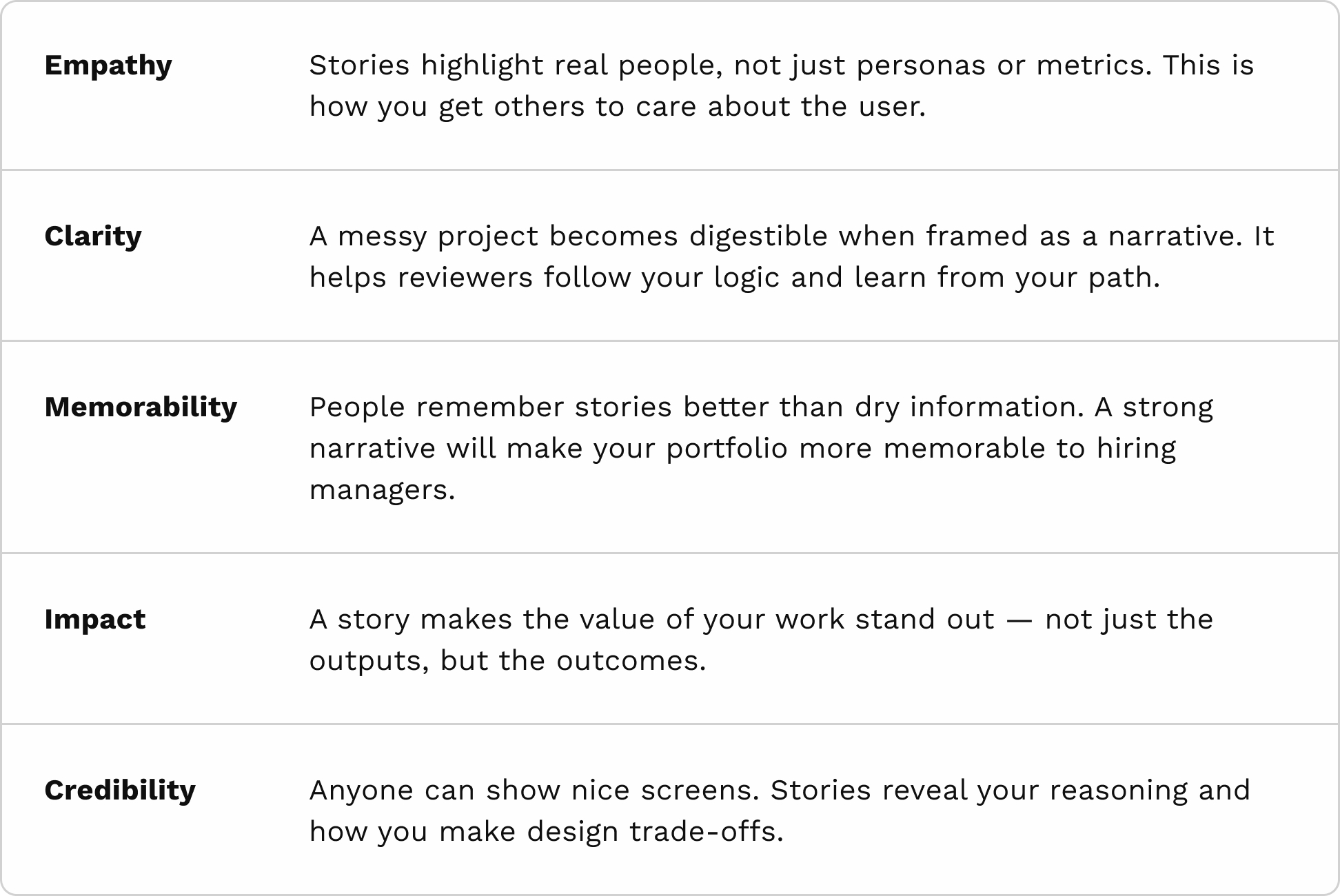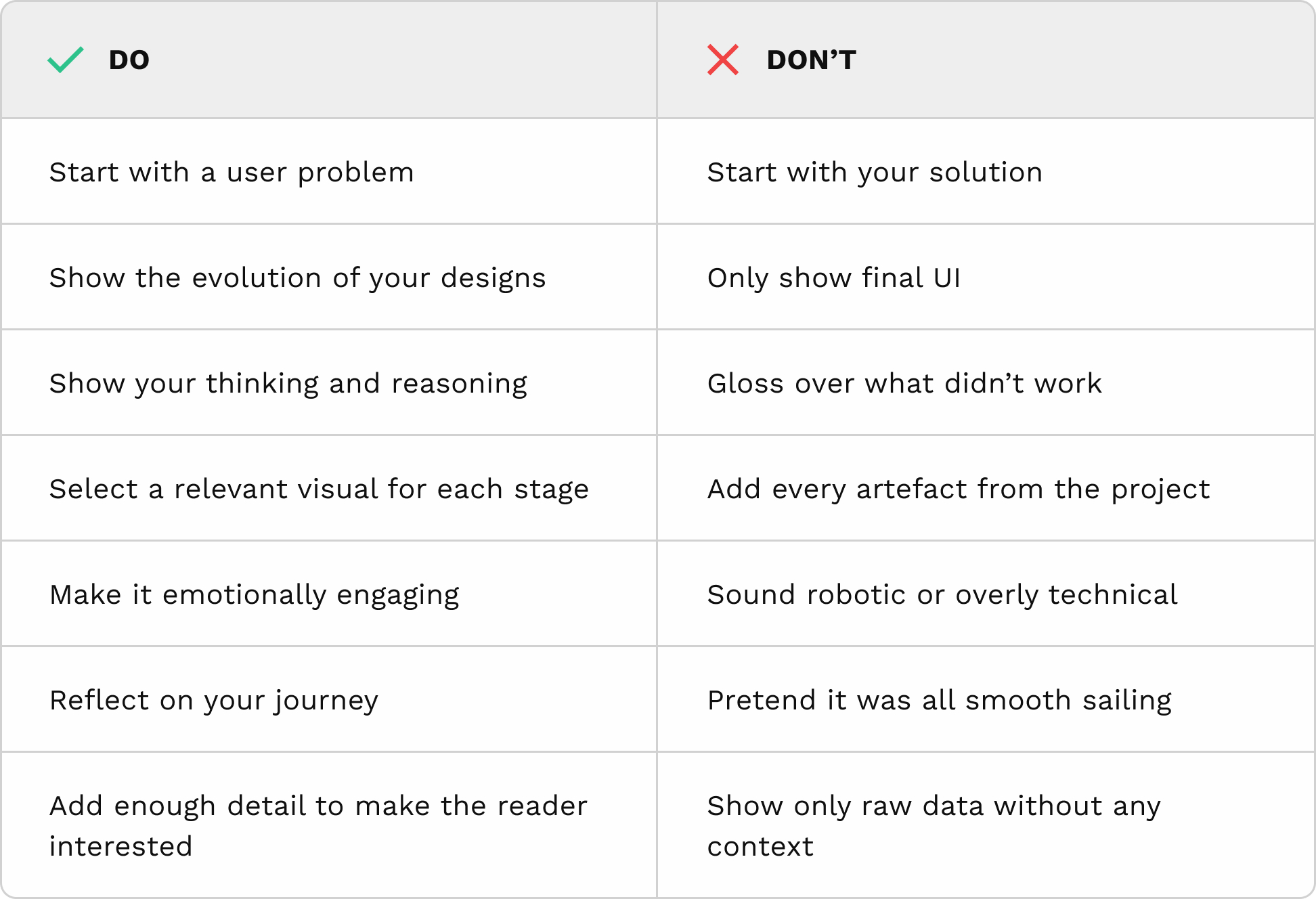Ever felt like your case study is just a list of steps and deliverables? Like it just makes your portfolio a collection of boring reports? That’s where UX storytelling comes in.
When done right, it turns your portfolio into a memorable, persuasive experience — one that shows not just what you did, but why it mattered, who it helped, and how you made decisions along the way.
In this guide, we’ll explore what UX storytelling really is, why it’s crucial for designers, and how you can craft story-driven narratives using simple, proven techniques — even if you don’t consider yourself a great writer.
What Is UX Storytelling?
UX storytelling is the practice of structuring your design work as a narrative — a sequence of meaningful events shaped by challenges, choices, and outcomes.
It’s not about fabricating drama, but about guiding readers through your thought process by showing your journey, not just the destination. It combines emotional storytelling with structured UX writing to clarify your impact.
You’ll find UX storytelling in:
- Portfolios and case studies – framing your work around the user’s journey
- Stakeholder presentations – explaining choices with narrative clarity
- UX writing and microcopy – guiding users through emotional friction
- UX education and workshops – making abstract topics feel human
- User research reporting – presenting insights in relatable, memorable ways
Stories are generally more persuasive and memorable than raw data. People tend to remember a good book over a sheer sheet of listed-out sentences, and for good reason — the former examples activate more parts of the brain and increase emotional recall.
In UX, this translates to stronger engagement and deeper understanding of your work, which is exactly what you need to make a great impression.
Why Storytelling Matters in UX
Design isn’t just about solving problems. It’s about showing others how you solved them — and why it mattered.
Why UX storytelling is powerful:
A good case study, for example, isn’t just a slideshow of what you did. It’s a walk-through of why you did it, and what it changed. Let’s take a look at some examples.

Real-World UX Storytelling Use Cases
UX storytelling goes far beyond just writing case studies. It’s a communication skill that cuts across every layer of the design process — from explaining your work to guiding users through it. Here’s how storytelling shows up in four core UX practices:
Portfolios and Case Studies
What it is: Framing your design journey like a narrative — from challenge to resolution, a great way to do case study storytelling.
Why it works: Recruiters and hiring managers aren’t just scanning for skills. They want to understand how you think. A story gives them context, logic, and impact.
Example:
Instead of listing:
“Ran usability test → Updated homepage layout → Improved conversion by 18%”
Put it like this:
“Users hesitated on the homepage because the value proposition wasn’t clear. One participant said, ‘I’m not sure what this site is for.’ So we tested new layouts with a stronger headline and visual hierarchy. The winning version led to an 18% lift in signups.”
Tip: Focus on turning points — a moment of insight, a tough trade-off, a surprising test result — to keep the story dynamic and human.
Stakeholder Presentations
What it is: Using storytelling to align non-design stakeholders with your goals, research, and design rationale.
Why it works: Numbers alone don’t move hearts. Stories do. A clear user narrative can shift decisions and build support.
Example:
Start with a user:
“Meet Jamal. He’s 28, works night shifts, and accesses our platform on a 7-year-old Android phone. He told us, ‘I just want to check my hours fast and get out.’ But the current login flow took him 6 taps and 40 seconds.”
Then frame your design as a response:
“Our redesign reduced login time to 8 seconds — a small change with a big human impact.”
Tip: Follow a story arc — Setup (user problem), Conflict (friction), and Resolution (your design). Use quotes and photos if possible to keep the human at the center.
UX Writing & Microcopy
What it is: Applying storytelling principles to the smallest touchpoints — buttons, error messages, onboarding flows — to guide users emotionally and functionally.
Why it works: Microcopy isn’t just about being clear — it’s about anticipating how users feel. That’s storytelling at a micro-scale.
Example:
Instead of:
“Error: Invalid credentials.”
Say:
“Hmm, that didn’t work. Want to try again or reset your password?”
This turns frustration into reassurance, and puts the user back in control — a classic emotional beat in UX storytelling.
Tip: Think of each micro-interaction as a mini-scene. What is the user thinking right now? What’s the tone they need? Are you helping them move forward?
UX Workshops & Education
What it is: Teaching concepts like accessibility, prototyping, or research with relatable narratives and scenarios.
Why it works: Abstract principles become sticky when anchored in lived experiences. Stories make new knowledge easier to absorb and remember.
Example:
Instead of listing accessibility guidelines, tell a story:
“When we tested the new color scheme, Elena — a legally blind participant — couldn’t see the call-to-action button at all. She said, ‘I just kept scrolling, thinking I missed something.’ That was our wake-up call.”
Tip: When teaching, borrow from classic storytelling tools:
- Introduce characters (users, teammates, test participants)
- Build tension (what went wrong or was misunderstood)
- Show transformation (what you changed, what was learned)
A Simple Way of Doing UX Storytelling
Use this 5-part arc to craft better UX case studies and presentations:
1. The Problem (The Setup)
Introduce the situation. What was broken? Who did it affect? Make the user’s pain vivid — not just functional, but emotional.
“Users couldn’t complete checkout on mobile — not just due to bugs, but because they felt overwhelmed and unconfident.”
2. The User (The Character)
Introduce the people behind the data. Share quotes, frustrations, even a short backstory. This builds emotional investment.
“Ana, a 32-year-old mother, said she ‘gave up’ on the app because it felt like ‘filling out a government form’.”
3. The Process (The Journey)
This is the action — what you explored, built, failed at, and iterated on. Include decision points, turning moments, and unexpected insights. Don’t shy away from what didn’t work.
“We thought removing steps would help. But usability tests showed users needed those steps to feel in control. So we redesigned with clarity in mind.”
4. The Result (The Resolutioen)
Show what changed. Metrics are good — context is better. Tell what success meant for users, business, or team operations.
“After redesign, mobile completion rates rose by 22%. But more importantly, satisfaction scores jumped from 3.1 to 4.6.”
5. The Reflection (The Epilogue)
Share what you learned, how you grew, and what you’d improve. This shows maturity and thoughtfulness.
“Looking back, I’d involve developers earlier — our assumptions caused extra work.”
Do’s and Don’ts of UX Storytelling

How UXfolio Helps You Tell Better Stories
We built UXfolio specifically to help you tell better stories, without needing to wrestle with clunky tools or empty pages.
Here’s how UXfolio supports storytelling:
- AI case study generator
Kickstart a structured, story-driven draft by entering just a few details - UX-specific sections
Choose from our ready-made UX sections (like Interviews or Usability testing) that help you tell the story of your designs, and guide you through telling your story - Built-in device mock-ups
Upload your screenshots right into our professional device mock-ups to support your narrative - Easy customization
With curated color palettes and font pairs, you can transform your portfolio to fit your personality with a single click
Even if you’re not confident in your writing, we give you the scaffolding to craft a UX portfolio that feels smart, human, and true to your process
Final Thoughts
UX storytelling isn’t fluff. It’s a strategy.
It helps others see what you see, feel what you felt, and believe in the work you did. It makes your process understandable, your work memorable, and your voice distinct.
If you want to stand out as a designer, don’t just show screens — master the art of portfolio storytelling in UX.
Try UXfolio today, and start telling better stories.